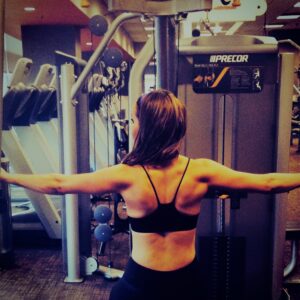As part of this series, in the interest of full transparency AND possibly giving you some great ideas, I will provide a tracker of all my meals and workouts for the week. Each week, a new exercise and meal plan will be published. I keep a repository of recipes HERE.
DAOFitlife Meal Plan -Week 1
This plan will change week after week. As a static constant, it will embody principles from the following articles:
- The DAO approach to food , eating, and meal planning – keeping it simple, variety cycling, and keeping ready to go meals and snacks on hand;
- The 80//20 approach: Incorporating joy eats in a meal and/or snack per week;
- The 5:2 intermittent fasting method that I discuss in my intermittent fasting article;

Customizable DAOFitLife Meal Plan and Grocery List Links
- Customizable DAOFitLife Meal Plan and Grocery List Template Google Sheet
- Downloadable DAOFitLife Meal Plan and Grocery List Template Excel Document
- Printable DAOFitLife Meal Plan and Grocery List Template PDF
Food
Generally I follow a diet of lean proteins, lots of fruit, vegetables, and “low” dairy. Any meal I have during the day takes 5 minutes or less to make.
I follow the DAO approach to food, which is the PFfCW framework. Each meal or snack includes protein, carbs, fiber, and fat. And I drink at least
I follow the 5:2 fasting regime. On 2 days a week, I eat 600-800 calories, the rest of the week I aim for 1400-1600. The point of the fasting days is to reset and renew the system. On those days, I don’t eat animal products, instead focusing on getting a lot of fruits, vegetables, and staying hydrated. .
Regardless of day, I generally eat 3 meals and 2 snacks a day after at least a 12 hour overnight fast. So if my last snack is at 830pm, I generally won’t eat breakfast until 9am the next morning. After my 5:2 days, I load up on protein the next morning.
My meal timing on regular nonfasting days is usually like:
- 9am breakfast
- 1pm lunch
- 330-4pm snack
- 7-730 dinner dinner
- 730-8 after dinner snack (my greek yogurt with a light touch of honey- which is great before bedtime)
Recipes are available HERE. I will update this link week after week after adding more recipes.
DAOFitlife Exercise Plan- Week 1

Workout Template Links
- Customizable DAOFitLife Workout Plan Google Sheet Template
- Downloadable DAOFitLife Workout Plan Excel Document
- Printable DAOFitlife Workout Plan PDF
What workout to do – and exactly what do all those acronyms mean
There seem to be endless option – but they really only fall into four buckets – low/medium intensity cardio, high intensity cardio, strength training and precision training. There are also terms like LISS, MISS, and HIIT that we should briefly review:
- Low intensity cardio or “LISS” – this includes walking, elliptical, jogging, swimming, stairmaster, or cycling. Any of these above activities, done at a faster pace, for example, running, power walking, arc trainer, or spinning can be “MISS” or medium intensity steady state cardio. It also includes cardio-based classes like boxing, tabata and zumba. You are exerting yourself, but not getting your heart rate above 160 BPM.
- High intensity interval training or “HIIT” – This consists of “sprint” intervals that are supposed to get your heart pounding to the point where you are struggling to breathe (about 90 percent max). The thing is that they are quick so you can recover and repeat. HIIT splits can be done in any combinations of work and rest – 30/30, 45/15, 20/10, 60/60, and so forth. Any of the above activities can be done in sprints – running, Stairmaster, rowing, etc. HIIT also includes plyometric-based training, which is a series of bodyweight movements usually but not always involving jumping to raise your heart rate. Think jump squats, mountain climbers, burpees, and jump lunges. Most “HIIT workouts” incorporate a combination of all of these plus movements that work your whole body, like pushups and core work.
Here is an article that more comprehensively explains the difference between HIIT, MISS, and LISS.
- Strength training and conditioning – this is a broad category, broader than crossfit or weightlifting. The term ‘strength and conditioning training’ refers to the format of exercise which highlights building the strength, size as well as endurance of skeletal muscle. It can include these types of workouts as tools, but it is also good to be aware that you don’t have to be picking up a weight or kettlebells to be strength training. Working on agility, balance, and functional movements are all a part of this. Therefore this category also includes “animal flow” type of movements like bear crawls and frog walks.
- Precision training – precision training refers to any focus on smaller muscles and movements. So here think yoga, barre, and Pilates,
A comprehensive formula- LISS + HIIT + STRENGTH = FIT!
I follow an exercise regime based on steady state cardio 5 days a week, and high intensity interval training twice a week, strength training twice a week, and precision training (yoga, Pilates or barre) twice a week. The formula I follow for working out is as follows:
- 2 HIIT training sessions a week
- 45 min of steady state cardio(LISS OR MISS) 5 times a week
- 2 resistance training sessions twice a week
- 2 precision training sessions a week
- 1 complete rest day
Note that my steady state cardio is done while on work calls; therefore during the week, my net time spent working out daily is 20-30 minutes.
How did I come up with this? Fitness, like business, is about holistic solutions
My approach is based on years of experimenting, working with trainers, and following specific apps and programs. The bottom line is what I learned you can’t do too much of one thing or your body won’t change. You need to mix it up.
If you think back to when we were working out interactively, you will notice what I always noticed.
- People in the who walked or ran on the treadmill every day
- People who are always only lifting weights
- People who are permanent fixtures in yoga class, spin class, barre class, etc.
And the more I observed, the more I noticed that for the most part, these people’s bodies were not changing. Maybe that’s not why they were doing what they were doing. But if you do want change, and want noticeable results, I think that doing the same thing over and over is a form of insanity – you can’t possibly expect to get results. So my formula covers all of the bases.
I have also experienced the effects of not having a well-rounded workout regime. When I only focused on cardio, I lost muscle and gained fat. When I cut out cardio, I gained muscle and gained fat. When I only did yoga and barre, my body stopped responding after a while.
How you tweak this program will depend on your body type and your diet. If you eat more, you need to burn more calories. If you have a different body type, you may not need to do as much cardio. Keep in mind that this is only a baseline guide and not prescriptive.
Key takeaway
You can and will find your rhythm when it comes to meal planning and working out. It only takes 3 pillars: Ability, time, and motivation. I have helped you find your motivation and your why. I have helped you with finding the time. The ability may seem daunting at first, but so was your first day at your new job. And look where you are now. You can do that, and you can do this too.






